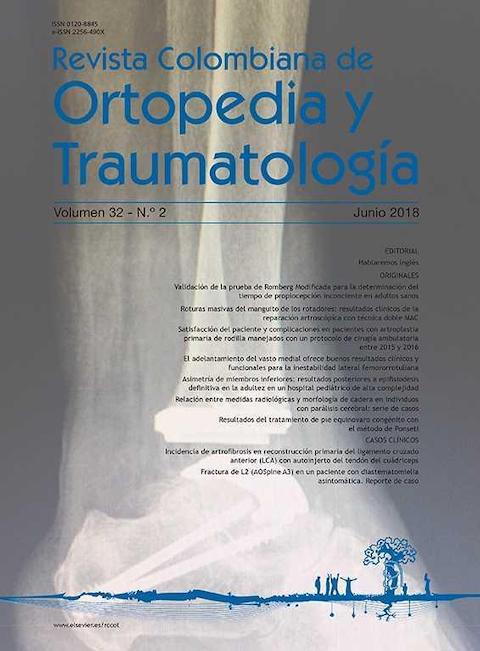El adelantamiento del vasto medial ofrece buenos resultados clínicos y funcionales para la inestabilidad lateral femororrotuliana
DOI:
https://doi.org/10.1016/j.rccot.2017.09.005Palabras clave:
inestabilidad lateral femororrotuliana, adelantamiento del vasto medial, tratamientoResumen
Introducción: La inestabilidad lateral femororrotuliana es una patología de etiología multifactorial aunque existen múltiples opciones para su tratamiento. El adelantamiento del vasto medial con liberación retinacular lateral asistida por artroscopia (AVMLRAA) se realiza cuando no hay alteraciones de alineación ni de la estructura ósea. El objetivo del estudio es evaluar los resultados clínicos y funcionales de pacientes con inestabilidad lateral femororrotuliana (ILFR) tratados con AVMLRAA.
Material y métodos: Estudio descriptivo y transversal realizado entre septiembre de 2014 y enero de 2016. Se incluyó a pacientes con ILFR tratados con AVMLRAA. Se presentan los resultados evaluados por las escalas de Tegner-Lysholm y Kujala antes de la cirugía y 12meses después de operados.
Resultados: Seis pacientes, 5 mujeres (83,3%) y 1 hombre (16,7%); media de edad al presentar la primera luxación: 15,83 (7-30) ±8,47 años; rodilla afectada: 4 derechas (66,7%) y 2 izquierdas (33,3%); tiempo promedio desde la primera luxación hasta la cirugía: 10,08 (0,5-17) ±5,16 años; las evaluaciones prequirúrgicas y posquirúrgicas de las escalas Tegner-Lyshom y Kujala para el género y lado afectado no mostraron diferencias estadísticamente significativas (p>0,05). La mediana prequirúrgica de la escala Tegner-Lysholm fue 37,50 (6-78) ±26,66; posquirúrgica: 88,17 (77-99) ±7,73 (p = 0,028); mediana de la escala Kujala prequirúrgica: 36,67 (2-77) ±29,703; posquirúrgica: 84,83 (75-100) ±9,368 (p = 0,027). El seguimiento promedio fue 14,0 (12-18) ±2,44 meses; la aprensión posquirúrgica fue 100% negativa. El 100% respondió que se volverían a operar en caso de presentar nuevamente los síntomas.
Discusión: El AVMLR para el manejo de la ILFR en pacientes sin malformaciones óseas ni mala alineación ofrece buenos resultados clínicos.
Nivel de evidencia clínica: Nivel IV.
Descargas
Referencias bibliográficas
Weber AE, Nathani A, Dines JS, Allen AA, Shubin-Stein BE, Arendt EA, et al. An algorithmic approach to the management of recurrent lateral patellar dislocation. J Bone Joint Surg Am. 2016;98:417-27. https://doi.org/10.2106/JBJS.O.00354
Askenberger M, Janarv PM, Finnbogason T, Arendt EA. Morphology and anatomic patellar instability risk factors in first-time traumatic lateral patellar dislocations. Am J Sports Med. 2017;45:50-8. https://doi.org/10.1177/0363546516663498
Antinolfi P, Bartoli M, Placella G, Speziali A, Pace V, Delcogliano M, et al. Acute patellofemoral instability in children and adolescents. Joints. 2016;4:47-51. https://doi.org/10.11138/jts/2016.4.1.047
Fithian DC, Paxton EW, Stone ML, Silva P, Davis DK, Elias DA, et al. Epidemiology and natural history of acute patellar dislocation. Am J Sports Med. 2004;32:1114-21. https://doi.org/10.1177/0363546503260788
Jain NP, Khan N, Fithian DC. A treatment algorithm for primary patellar dislocations. Sports Health. 2011;3:170-4. https://doi.org/10.1177/1941738111399237
Nietosvaara Y, Paukku R, Palmu S, Donell ST. Acute patellar dislocation in children and adolescents. Surgical technique. J Bone Joint Surg. 2009;91:139-45. https://doi.org/10.2106/JBJS.H.01289
Desio SM, Burks RT, Bachus KN. Soft tissue restraints to lateral patellar translation in the human knee. Am J Sports Med. 1998;26:59-65. https://doi.org/10.1177/03635465980260012701
Panagiotopoulos E, Strzelczyk P, Herrmann M, Scuderi G. Cadaveric study on static medial patellar stabilizers: The dynamizing role of the vastus medialis obliquus on medial patellofemoral ligament. Knee Surg Sports Traumatol Arthrosc. 2006;14:7-12. https://doi.org/10.1007/s00167-005-0631-z
Colvin AC, West RV. Patelar instability. J Bone Joint Surg Am. 2008;90:2751-62. https://doi.org/10.2106/JBJS.H.00211
Balcarek P, Oberthür S, Frosch S, Schüttrumpf JP, Stürmer KM. Vastus medialis obliquus muscle morphology in primary and recurrent lateral patellar instability. Biomed Res Int. 2014;2014:326586. https://doi.org/10.1155/2014/326586
Goh JC, Lee PY, Bose K. A cadaver study of the function of the oblique part of vastus medialis. J Bone Joint Surg Br. 1995;77:225-31. https://doi.org/10.1302/0301-620X.77B2.7706335
Arshi A, Cohen JR, Wang JC, Hame SL, McAllister DR, Jones KJ. Operative management of patellar instability in the United States. Orthop J Sports Med. 2016;4:1-7. https://doi.org/10.1177/2325967116662873
Beckert MW, Albright JC, Zavala J, Chang J, Albright JP. Clinical accuracy of J-sign measurement compared to magnetic resonance imaging. Iowa Orthop J. 2016;36:94-7.
Sallay PI, Poggi J, Speer KP, Garrett WE. Acute dislocation of the patella. A correlative pathoanatomic study. Am J Sports Med. 1996;24:52-60. https://doi.org/10.1177/036354659602400110
Ahmad CS, McCarthy M, Gomez JA, Shubin Stein BE. The moving patellar apprehension test for lateral patellar instability. Am J Sports Med. 2009;37:791-6. https://doi.org/10.1177/0363546508328113
Koh JL, Stewart C. Patellar instability. Orthop Clin North Am. 2015;36:147-57. https://doi.org/10.1016/j.ocl.2014.09.011
Laurin CA, Dussault R, Levesque HP. The tangential X-ray investigation of the patellofemoral joint: X-ray technique, diagnostic criteria and their interpretation. Clin Orthop Relat Res. 1979;144:16-26. https://doi.org/10.1097/00003086-197910000-00004
Merchant AC, Mercer RL, Jacobsen RH, Cool CR. Roentgenographic analysis of patellofemoral congruence. J Bone Joint Surg Am. 1974;56:1391-6. https://doi.org/10.2106/00004623-197456070-00007
Aglietti P, Insall JN, Cerulli G. Patellar pain and incongruence. I: Measurements of incongruence. Clin Orthop Relat Res. 1983:217-24. https://doi.org/10.1097/00003086-198306000-00032
Dejour H, Walch G, Nove-Josserand L, Guier C. Factors of patellarinstability: an anatomic radiographic study. Knee Surg Sports Traumatol Arthrosc. 1994;2:19-26. https://doi.org/10.1007/BF01552649
Nomura E, Inoue M. Cartilage lesions of the patella in recurrent patellar dislocation. Am J Sports Med. 2004;32:498-502. https://doi.org/10.1177/0095399703258677
Henry JK, Craven PR. Surgical treatment of patellar instability: Indications and results. Am J Sports Med. 1981;9:82-5. https://doi.org/10.1177/036354658100900202
Nam EK, Karzel EP. Mini-open medial reefing and arthroscopic lateral release for the treatment of recurrent patellar dislocation. Am J Sports Med. 2005;33:220-30. https://doi.org/10.1177/0363546504267803
Tegner Y, Lysholm J. Rating systems in the evaluation of knee ligament injuries. Clin Orthop Relat Res. 1985:43-9. https://doi.org/10.1097/00003086-198509000-00007
Kujala UM, Jaakkola LH, Koskinen SK, Taimela S, Hurme M, Nelimarkka O. Scoring of patellofemoral disorders. Arthroscopy. 1993;9:159-63. https://doi.org/10.1016/S0749-8063(05)80366-4
Gil-Gámez J, Pecos-Martín D, Kujala UM, Martínez-Merinero P, Montañez-Aguilera FJ, Romero-Franco N, et al. Validation and cultural adaptation of "Kujala Score" in Spanish. Knee Surg Sports Traumatol Arthrosc. 2016;24:2845-53. https://doi.org/10.1007/s00167-015-3521-z
Beighton P, Solomon L, Soskolne L. Articular mobility in an African population. Ann Rheum Dis. 1973;32:413-8. https://doi.org/10.1136/ard.32.5.413
Atkin DM, Fithian DC, Marangi KS, Stone ML, Dobson BE, Mendelsohn C. Characteristics of patients with primary acute lateral patellar dislocation and their recovery within the first 6 months of injury. Am J Sports Med. 2000;28:472-9. https://doi.org/10.1177/03635465000280040601
Shah JN, Howard JS, Flanigan DC, Brophy RH, Carey JL, Lattermann C. A systematic review of complications and failures associated with medial patellofemoral ligament reconstruction for recurrent patellar dislocation. Am J Sports Med. 2012;40:1916-23. https://doi.org/10.1177/0363546512442330
Parikh SN, Nathan ST, Wall EJ, Eismann EA. Complications of medial patellofemoral ligament reconstruction in young patients. Am J Sports Med. 2013;41:1030-8. https://doi.org/10.1177/0363546513482085









